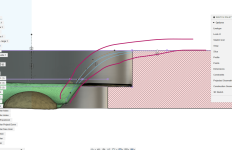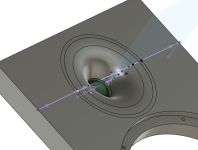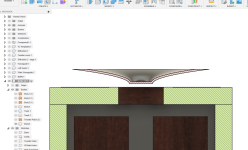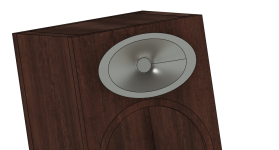Power response is more important here. This is going in quite a large room now. The focus has changed a bit since originally I was going to stick these in my office but now they are going in the large living room/kitchen area of the lakehouse.@Arthur Jackson Using a bit like that freehand is quite gutsy. You'd obviously need to go at it in several steps to make it turn out clean.
@Bmsluite You would have likely gained more from offset driver placement than the radius by itself. No doubt the radius would help some on its own, but a golden ratio driver offset would have a noticeable positive impact on the midrange linearity.
I've used wider baffles with good ÷. That mimics sideways speaker placement on a monitor desk. The larger wiggles you get with your typical 6 - 7" 2 way monitor can be minimized a little by running the tweeter HP up higher so the woofer has more directivity in that range. It may be worse with power response, but it improved off axis linearity based on my previous findings working with smaller PMC clones I built using the SS D2905-9700 + 18W8542-00 (not the newer -10 which IMO sounds worse). I tried moving around the xover by a wide range and settled on about 3k LR2.
Is the Golden Ration the curve that is most used for acoustic horn designs?
Returning to the OP topic of edge diffraction effects rather than waveguide design, I am grateful for Juhazi's post showing the effect of placing a tweeter in the end of a cylindrical tube in designs like the B&W 801-d4-Signature. The Stereophile measured on-axis response almost perfectly replicates the un-even behaviour obtained by the Olson paper, Fig 2c, Fig 8. The on axis peak-to-peak variation approaches 10 dB!A good bad example are B&W speakers with more or less teardrop enclosures for M and T https://www.stereophile.com/content/bowers-wilkins-801-d4-signature-loudspeaker-measurements
View attachment 1357190
I don't think that is the result of the tube, B&W seem to find creative ways to bork good acoustic designs elements.I am grateful for Juhazi's post showing the effect of placing a tweeter in the end of a cylindrical tube in designs like the B&W 801-d4-Signature.
Here is a comparison of a tube vs a sphere, the tube is different for sure but it is not bad.
https://www.diyaudio.com/community/threads/headshakes-far-field-3way.382393/post-7148880
This looks to be heading a better direction but I can't tell exactly what is being done. making an insert to go down to the surround is possible but could alter the directivity to be narrower which may be good or bad. The existing profile looks conical, adding a larger round over to the edge of it will terminate it more smoothly and make it behave better. replacing the waveguide entirely opens up lots of possibilities but it is not possible to guess the outcome by eyeballing the profile. Soft domes don't simulate very accurately as they are anything but pistonic over a large portion of their range.What do we think about this waveguide curve?
Change like these can alter enough that the existing crossover might need to be changed if that is a consideration.
I can't replace the built in waveguide. It's built in. So I can go down around the inside of it or I can just mount the tweeter flush and round over the edges after the fact for diffractionThis looks to be heading a better direction but I can't tell exactly what is being done. making an insert to go down to the surround is possible but could alter the directivity to be narrower which may be good or bad. The existing profile looks conical, adding a larger round over to the edge of it will terminate it more smoothly and make it behave better. replacing the waveguide entirely opens up lots of possibilities but it is not possible to guess the outcome by eyeballing the profile. Soft domes don't simulate very accurately as they are anything but pistonic over a large portion of their range.
Change like these can alter enough that the existing crossover might need to be changed if that is a consideration.
I think making a separate add on baffle that contains all the diffraction control elements is the simplest way to go. Mounting the tweeter flush to that baffle and starting a transition to the baffle edge as close to the face plate as possible. That would look similar to the blue coloured baffle design I showed before and contain some elements that you have already drawn in Fusion.
You could use that as a test bed for different edge shapes or amounts of flat baffle area if you are interested in measuring the effects they have.
If you want to see the effect of sharp corners vs fully rounded on all edges you can make a larger add on baffle and make some add on edges and panels in a similar vein to you first ideas.
You could use that as a test bed for different edge shapes or amounts of flat baffle area if you are interested in measuring the effects they have.
If you want to see the effect of sharp corners vs fully rounded on all edges you can make a larger add on baffle and make some add on edges and panels in a similar vein to you first ideas.
I can do that too. My plan is to make inserts.
So I can make an inter that mounts the tweeter flush to the baffle. And I cna make inserts that mount the tweeter lower down that include all sorts of waveguides
In this way I can infinitely test waveguides while only having to print the big baffle once. Saves a lot of filament
So I can make an inter that mounts the tweeter flush to the baffle. And I cna make inserts that mount the tweeter lower down that include all sorts of waveguides
In this way I can infinitely test waveguides while only having to print the big baffle once. Saves a lot of filament
Yes running a big honking bit like that in a small cheap router at high speed with a single cut is flirting with disaster. I usually use a big bit like that one, 3” across, in a router table with a 2 1/2 horsepower router, running slow, and I sneak up on the final dimension. Never cut that much material in a single pass with a hand held router. Having said that, I have used large 1” round over bits safely in my smaller router by turning the speed down, using a really large offset router base, and making several light cuts.@Arthur Jackson Using a bit like that freehand is quite gutsy. You'd obviously need to go at it in several steps to make it turn out clean.
I hear the new iphones are able to do that. I don’t know the accuracy though. Jeeze, and I thought Thingmakers were cool when I was a kid.Fluid,
Welp.... out comes the $5,000 3d scanner then....
I'll scan the tweeter and try to continue the built in waveguide
We have data!!!
You can go through them yourself but the pattern I see here is a 1-2 db improvement on the off axis response accross the board. This is especially noticeable in the 800-3k range.
Forum server is saying the MDAT is too large to attach here so I may have to make a google driver folder to hold them for whoever wants to go through it in detail.
I made all the colors the same. The baffle measurements are dark colored and the sharp baffle are the light color of the same color.
Anyways....this is pretty cut and dry.
In my opinion this is a small improvement. Possibly it is a greater improvement to the actual listening experience than is shown in the measurements. Measurements do not tell the whole story. With that being said, they do look ******* awesome. This new filament I have been using is just amazing. I will be wrapping these in alcantara. That may affect the response a bit so I'll probably take another round of measurements being starting the XO.
You can go through them yourself but the pattern I see here is a 1-2 db improvement on the off axis response accross the board. This is especially noticeable in the 800-3k range.
Forum server is saying the MDAT is too large to attach here so I may have to make a google driver folder to hold them for whoever wants to go through it in detail.
I made all the colors the same. The baffle measurements are dark colored and the sharp baffle are the light color of the same color.
Anyways....this is pretty cut and dry.
In my opinion this is a small improvement. Possibly it is a greater improvement to the actual listening experience than is shown in the measurements. Measurements do not tell the whole story. With that being said, they do look ******* awesome. This new filament I have been using is just amazing. I will be wrapping these in alcantara. That may affect the response a bit so I'll probably take another round of measurements being starting the XO.
Attachments
-
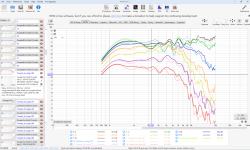 Screenshot 2024-09-21 215840.png302.9 KB · Views: 161
Screenshot 2024-09-21 215840.png302.9 KB · Views: 161 -
 Screenshot 2024-09-21 220407.png400.6 KB · Views: 147
Screenshot 2024-09-21 220407.png400.6 KB · Views: 147 -
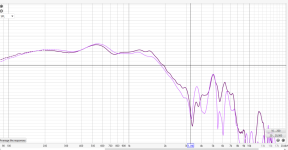 Screenshot 2024-09-21 220623.png89.4 KB · Views: 154
Screenshot 2024-09-21 220623.png89.4 KB · Views: 154 -
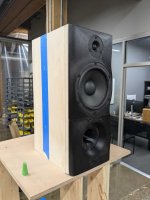 PXL_20240922_014422479.jpg373 KB · Views: 167
PXL_20240922_014422479.jpg373 KB · Views: 167 -
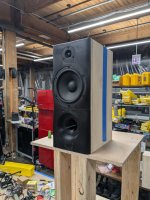 PXL_20240922_014416078.jpg430.4 KB · Views: 176
PXL_20240922_014416078.jpg430.4 KB · Views: 176 -
 PXL_20240922_014418096.jpg391.3 KB · Views: 167
PXL_20240922_014418096.jpg391.3 KB · Views: 167
@Bmsluite
I’m looking at those curves on my phone so excuse me if I not seeing things properly.
If β denotes the measurements with the shaped baffle. of the improvement seems to be in the region above ~1KHz.
@fluid
The designs of B&W, as a company, may seen a little, err, inconsistent. But when viewed through the lens of the people working the company, it makes a little more sense.
After releasing the 801 in 1979, 3 way box with minimal baffles and 45 degree facets.

https://www.bowerswilkins.com/en-us...PmO5XBG8kmHRtt01Ee86meXwJmoksbt93BgPrkoB85Y7p
John Bowers continued his quest in designing the ultimate loudspeaker, culminating in the Matrix 801, released in 1987 prior to his death from cancer. The team at Steyning Research Establishment took over the project. Lawrence Dickie was tasked with continue this project. Instead of pursuing the dipole or backless speakers that John had focused on, Lawrence decided to maximum absorption instead. Here’s one of his the early prototypes:

Reference:
https://www.bowerswilkins.com/en-us...ign=305950&utm_content=0&clickId=1101lzKjMG2E
Sometime in 1991, a (Police) Force(d) chance encounter with a young DIYer by the name of Simon Ghahari, who, inspired by the 80s acid house scene that he worked in, “…developed an intuitive foundation point. I began to imagine the sound like a liquid and the ripple as the movement of sound. It made the cabinet shape important to the sound waves. Round cabinets made sense because of the lack of flat surfaces and sharp edges”
This enthusiastic encounter started a relationship that would involve Lawrence doing the crossover, with B&W drive units, after Simon made the cabinets. Here’s was an early DIY cabinet:

Reference:
https://www.blueroomsounds.com/future-shape-of-sound
Lawrence continued at B&W, which was now under the ownership Robert Trunz. Here are some prototypes from 1991 and 1992 respectively:
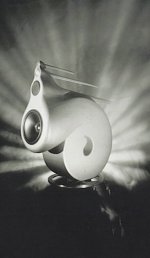
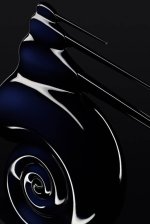
Meanwhile, Simon and Lawrence, in 1992, designed a Sound System for the Great Escape nightclub in Brighton UK, which included a speaker with a sealed MMT layout, named TechnoPod:

with a wall of TWENTY-FOUR 12" (B&W 801) woofers (left)

Reference:
https://www.blueroomsounds.com/future-shape-of-sound
The in 1993, B&W released their (now iconic) Nautilus:

Robert Trunz later sold his stake in B&W in 1997, and split away from B&W (taking Blue Room Sounds with him)
Lawrence Dickie left B&W in 1997 to do independent consulting before joining for Turbosound (1999-2013) before founding his own Vivid Audio (2004)
It's amazing to realise that much of the design work was done before the release of MLSSA, a hardware/software to measure speakers on-axis, in DOS

As late as 2014, measurements at B&W were taken on-axis, using WinMLS Pro (personal communication, no reference will be provided)
It's not clear what software, microphone or process is used to measure/design their speakers since 2014... but as late as 2023, it isn't clear to me if other people know either
B&W's market failure with their Formation active speaker and headphones partly because it was over budget and delayed.
A series of different CFO and CEOs from 2016 couldn't help:
https://www.whathifi.com/news/bowers-and-wilkins-ceo-resigns-restructuring-expert-appointed
B&W was acquired by Sound United LLC (USA) in 2020, the holding company that owned Definitive Technology, Polk Audio, Denon, Marantz
In 2022, Sound United was purchased by Masimo, the company founded by Massi Kiani, who invented the pulse oximeter, a device that measures oxygen levels carried in the bloodstream non-invasively (ie. external body contact only, akin to how a thermometer can temperature on contact). This device is used everywhere from Emergency departments, to hospital wards for millions of patients a year. However Massi was recently outsted and forced to resign from Masimo...
I’m looking at those curves on my phone so excuse me if I not seeing things properly.
If β denotes the measurements with the shaped baffle. of the improvement seems to be in the region above ~1KHz.
@fluid
The designs of B&W, as a company, may seen a little, err, inconsistent. But when viewed through the lens of the people working the company, it makes a little more sense.
After releasing the 801 in 1979, 3 way box with minimal baffles and 45 degree facets.
https://www.bowerswilkins.com/en-us...PmO5XBG8kmHRtt01Ee86meXwJmoksbt93BgPrkoB85Y7p
John Bowers continued his quest in designing the ultimate loudspeaker, culminating in the Matrix 801, released in 1987 prior to his death from cancer. The team at Steyning Research Establishment took over the project. Lawrence Dickie was tasked with continue this project. Instead of pursuing the dipole or backless speakers that John had focused on, Lawrence decided to maximum absorption instead. Here’s one of his the early prototypes:
Reference:
https://www.bowerswilkins.com/en-us...ign=305950&utm_content=0&clickId=1101lzKjMG2E
Sometime in 1991, a (Police) Force(d) chance encounter with a young DIYer by the name of Simon Ghahari, who, inspired by the 80s acid house scene that he worked in, “…developed an intuitive foundation point. I began to imagine the sound like a liquid and the ripple as the movement of sound. It made the cabinet shape important to the sound waves. Round cabinets made sense because of the lack of flat surfaces and sharp edges”
This enthusiastic encounter started a relationship that would involve Lawrence doing the crossover, with B&W drive units, after Simon made the cabinets. Here’s was an early DIY cabinet:

Reference:
https://www.blueroomsounds.com/future-shape-of-sound
Lawrence continued at B&W, which was now under the ownership Robert Trunz. Here are some prototypes from 1991 and 1992 respectively:


Meanwhile, Simon and Lawrence, in 1992, designed a Sound System for the Great Escape nightclub in Brighton UK, which included a speaker with a sealed MMT layout, named TechnoPod:
with a wall of TWENTY-FOUR 12" (B&W 801) woofers (left)
Reference:
https://www.blueroomsounds.com/future-shape-of-sound
The in 1993, B&W released their (now iconic) Nautilus:
Robert Trunz later sold his stake in B&W in 1997, and split away from B&W (taking Blue Room Sounds with him)
Lawrence Dickie left B&W in 1997 to do independent consulting before joining for Turbosound (1999-2013) before founding his own Vivid Audio (2004)
It's amazing to realise that much of the design work was done before the release of MLSSA, a hardware/software to measure speakers on-axis, in DOS
As late as 2014, measurements at B&W were taken on-axis, using WinMLS Pro (personal communication, no reference will be provided)
It's not clear what software, microphone or process is used to measure/design their speakers since 2014... but as late as 2023, it isn't clear to me if other people know either
B&W's market failure with their Formation active speaker and headphones partly because it was over budget and delayed.
A series of different CFO and CEOs from 2016 couldn't help:
https://www.whathifi.com/news/bowers-and-wilkins-ceo-resigns-restructuring-expert-appointed
B&W was acquired by Sound United LLC (USA) in 2020, the holding company that owned Definitive Technology, Polk Audio, Denon, Marantz
In 2022, Sound United was purchased by Masimo, the company founded by Massi Kiani, who invented the pulse oximeter, a device that measures oxygen levels carried in the bloodstream non-invasively (ie. external body contact only, akin to how a thermometer can temperature on contact). This device is used everywhere from Emergency departments, to hospital wards for millions of patients a year. However Massi was recently outsted and forced to resign from Masimo...
Last edited:
24 12" subs and those pods!? Clubs are so lame now with their crappy pro woofers
Soooo the nautilus was a ripoff? Crazy
Soooo the nautilus was a ripoff? Crazy
I wouldn't say that.
I would say that it was the collaboration of three individuals who loved music, in the spirit of DIY. From my vantage point Simon and Lawrence were both looking at ways to absorb the rear wave of a transducer, and manage diffraction. Robert was able to provide funding and direction away from the eyes of the board at B&W...
I haven't been to any clubs in the last decade, but I do recall some of the best night club sound systems from the late 90s/early 2000s eg. Twilo @NYC
This was the era of high directivity, thanks to people like Tony Andrews, during his time at Turbosound, and later when he founded Funktion-One.
 .
.
Here's the phenomenal sound system at Space @Ibiza
I would say that it was the collaboration of three individuals who loved music, in the spirit of DIY. From my vantage point Simon and Lawrence were both looking at ways to absorb the rear wave of a transducer, and manage diffraction. Robert was able to provide funding and direction away from the eyes of the board at B&W...
I haven't been to any clubs in the last decade, but I do recall some of the best night club sound systems from the late 90s/early 2000s eg. Twilo @NYC
This was the era of high directivity, thanks to people like Tony Andrews, during his time at Turbosound, and later when he founded Funktion-One.
Here's the phenomenal sound system at Space @Ibiza
Last edited:
Is it wierd I want to go to Ibiza only to hear the clubs sound systems and for no other reason?
- Home
- Loudspeakers
- Multi-Way
- Edge Diffraction Testing - Shapes
